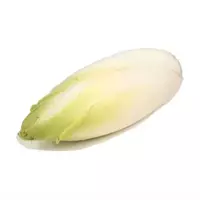Endivius

Endive has many synonymous names: chicory, chicory lettuce, escariol, frieze, radiccio. Some consider these plants to be close relatives, but their properties are so similar that they allow us to talk about them as a whole as one culture.
This plant has been known since ancient times. The first mention of it appears in India and Indonesia, then the endive was brought to Egypt, from where it spread throughout the Mediterranean coast. This is a cultivated plant, it is not found in the wild.
Endive was also cultivated in Russia before, but the complex growing technology and the bitter taste of leaves significantly weakened interest in it. A close relative of endivium, chicory, is widespread in Russia. It is extremely sensitive to light and heat, so it blooms in the middle of summer and is a kind of symbol of this time of year. Its flowering period coincides with the holiday of Petrov's Day, so the people widely know the very metaphorical name of chicory - "Petrov Batogi. "
Root chicory was cultured at the end of the 17th century in Holland and began to be used as a substitute for the most popular drink - coffee.
Endive benefit
Chicory roots during processing convert the inulin included in their composition into fructose and, accordingly, a dietary product devoid of glucose is obtained, which is extremely useful for people with diabetes mellitus. In the modern world, chicory extract is used as a flavor additive and dye.
The terrestrial part of this plant is used in the preparation of salads, it is stewed, boiled, served as a side dish. As already mentioned, endive has a kind of taste. However, the rather specific taste of this plant is more than compensated for by the beneficial properties of the endive. Endive is perhaps the richest vitamin A product. Thanks to this, endivium is an excellent tool for the prevention of cancer.
The endive contains a significant amount of vitamin C, calcium, iron, phosphorus, chlorine, potassium, which helps in the fight against hypertension, manganese, which is involved in the production of many enzymes. The benefits of endive in the presence of B vitamins, which have an extremely beneficial effect on the state of the nervous system, help to get rid of the effects of stress, restore peace of mind, return vigor and excellent mood.
Endive juice helps to get rid of many health problems. For example, it is effective for getting rid of acne, anemia, some eye diseases, liver and gallbladder diseases. The oral benefits of endive, in particular its juice, are also obvious. Since drinking it in its pure form is very difficult, experts recommend combining it with juices of other plants with a more pleasant taste. Thus, you will be able to feel the full effect of complex co-therapy. The calorie content of the endive is only 17 kcal. 100 gr. , therefore, most nutritionists from different countries advise to include this plant in their diet to maintain harmony and excellent health.
Endive harm
This asthenia has practically no contraindications. Endive harm can only be manifested in individual intolerance to the product. If you have doubts about whether endive is worth it or not, it is better to consult a specialist.
endive 17 kCal
Energy value of endive (Ratio of proteins, fats, carbohydrates - ju):
Proteins: 1.25 g (~ 5 kCal)
Fats: 0.2 g (~ 2 kCal)
Carbohydrates: 0.25 g (~ 1 kCal)
Energy ratio (bj | y): 29% | 11% | 6%
 Español
Español Français
Français Português
Português Русский
Русский 简体中文
简体中文 繁體中文
繁體中文 日本語
日本語 한국어
한국어 العربية
العربية Türkçe
Türkçe Қазақ
Қазақ Deutsch
Deutsch Italiano
Italiano Українська
Українська
